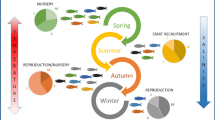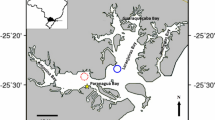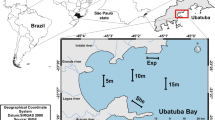Abstract
The life history traits of desert fishes indicate their resilience to environmental change and vulnerability to extirpation and extinction. Garra ghorensis is a small (<140 mm) riverine cyprinid fish endemic to the Southern Dead Sea area and is critically endangered through habitat loss and invasive species. Here, the reproductive ecology of three Jordanian populations of this species were assessed through the collection of monthly samples between February 2011 and January 2012 in a region where air temperatures ranged between below 0 °C and over 40 °C through the year. Samples contained fish up to 137 mm fork length, with most <100 mm. Fish matured at length below 40 mm and at ages <1 year. Except one population of female dominated, sex ratios were not significantly different from 1:1. Reproductive effort, as gonado-somatic index (I G ), peaked in both sexes in May, indicating spawning commenced soon after, with gonad maturation occurring at mean air temperatures below 20 °C and spawning above 20 °C. Mean female I G by month suggested protracted spawning throughout the summer months. Both mean I G and fecundity varied between sites, with the highest values at the most disturbed site. In combination, these outputs suggest G. ghorensis has an opportunistic life history strategy with sufficiently plastic reproductive traits that enable adaptation to shifting conditions. These are likely to provide resilience to habitat alterations and suggest that the plasticity of their reproductive traits might be important in developing strategies to safeguard their populations in the face of continued habitat degradation.





Similar content being viewed by others
References
Angermeier PL (1995) Ecological attributes of extinction-prone species: loss offreshwater fishes of Virginia. Conserv Biol 9:143–158
Bagenal TB, Braum E (1978) Eggs and early life history. In: Bagenal TM (ed.) IBP handbook. Methods for assessment of fish production in fresh waters
Blanck A, Lamouroux N (2007) Large-scale intraspecific variation in life-history traits of European freshwater fish. J Biogeogr 34:862–875
DeMaster DP (1978) Calculation of average age of sexual maturity in marine mammals. J Fish Res Board Can 35:912–915
Doupé RG, Schaffer J, Knott MJ, Burrows DW (2009) How might an exotic fish disrupt spawning success in a sympatric native species? Mar Freshw Res 60:379–383
Eby LA, Fagan WF, Minckley WL (2003) Variability and dynamics of a desert stream community. Ecol Appl 13:1566–1579
Goren MandOrtal R (1999) Biogeography, diversity and conservation of the inland water fish communities in Israel. Biol Conserv 89:1–9
Hamidan N, Britton JR (2014) Age and growth rates of the critically endangered fish Garra ghorensis can inform their conservation management. Aquat Conserv. doi:10.1002/aqc.2449
Hamidan N, Mir S (2003) The status of Garra ghorensisin Jordan: distribution, ecology and threats. Zool Middle East 30:114
IUCN (2012) Garra ghorensis. http: //www.iucnredlist.org/details/60335/0. Last accessed 04/11/13
Krupp F (1982) Garratibanicaghorensis subsp. nov. (pisces: Cyprinidae), an African element in the cyprinid fauna of the Levant. Hydrobiologia 8:319–324
Krupp F, Schneider W (1989) The fishes of Jordan River drainage Basin and Azraq Oasis. Fauna Saudi Arab 10:384–410
Martin CW, Valentine MM, Valentine JF (2010) Competitive interactions between invasive Nile tilapia and native fish: the potential for altered trophic exchange and modification of food webs. PLoS ONE: e14395.417
McKinney ML (1997) Extinction vulnerability and selectivity: combining ecological and paleontological views. Ann Rev Ecol Syst 28:495–516
Nunn AD, Cowx IG, Harvey JP (2002) Recruitment patterns of six species of cyprinid fishes in the lower River Trent, England. Ecol Freshw Fish 11:74–84
Olden JD, Poff NL, Bestgen K (2006) Life-history strategies predict fish invasions and extirpations in the Colorado River Basin. Ecol Monogr 76:25–40
Olden JD, Poff N, Bestgen KR (2008) Trait synergisms and the rarity, extirpation and extinction risk of desert fishes. Ecology 89:847–856
Oyugi D, Cucherousset J, Ntiba JM, Kisia SM, HarperDMand Britton JR (2011) Life history traits of an equatorial carp Cyprinuscarpio population in relation to thermal influences on invasive populations. Fish Res 110:92–97
Poff NL, Allan JD, BainMB KJR, Prestegaard KL, Richter BD, Sparks RE, Stromberg JC (1997) The natural flow regime. Bioscience 47:769–784
Pool TK, Olden JD (2012) Taxonomic and functional homogenization of an endemic desert fish fauna. Divers Distrib 18:366–376
Propst DL, Gido KB, Stefferud JA (2008) Natural flow regimes, nonnative fishes and native fish persistence in arid-land river systems. Ecol Appl 18:1236–1252
Reynolds JD, Webb TJ, Hawkins L (2005) Lifehistory and ecological correlates of extinction risk in European freshwater fishes. Can J Fish Aquat Sci 62:854–862
Richter BD, Mathews R, Harrison DL, Wigington R (2003) Ecologically sustainable water management: Managing river flows for ecological integrity. Ecol Appl 13:206–224
Rinchard Jand Kestemont P (1996) Comparative study of reproductive biology in single- and multiple-spawner cyprinid fish. I Morphol Histol Features J Fish Biol 49:883–894
Soto CG, Burhanuddin (1995) Clove oil as a fish anaesthetic for measuring length and weight of rabbitfish (Siganuslineatus). Aquaculture 136:149–152
Trippel EA, Harvey HH (1987) Reproductive responses of five white sucker Catostomuscommersoni populations in relation to lake acidity. Can J Fish Aquat Sci 44:1018–1023
Winemiller KO, Rose KA (1992) Patterns of life history diversification in North American fishes: implications for population regulation. Can J Fish Aquat Sci 49:2196–2218
Author information
Authors and Affiliations
Corresponding author
Rights and permissions
About this article
Cite this article
Hamidan, N., Britton, J.R. Reproductive ecology of Garra ghorensis, a critically endangered fish in Jordan. Environ Biol Fish 98, 1399–1409 (2015). https://doi.org/10.1007/s10641-014-0367-z
Received:
Accepted:
Published:
Issue Date:
DOI: https://doi.org/10.1007/s10641-014-0367-z




